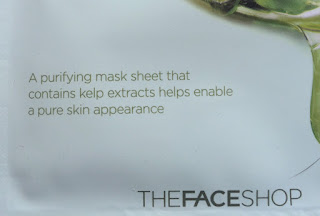Since going back to work I have been too tired to do sheet masks at night, which is sad. I really should make more of an effort because I've hardly made a dent in my stash and my aim was to have a third of them gone by now.
But this morning - Saturday morning, french toast, coffee, I decided to do a sheet mask. Dammit. I usually prep my skin for a mask by cleanse, tone, eye cream, serum (Mizon Snail bae right now - we're back together), then mask. After the mask has done its "thang" I follow up with however many moisturisers my skin wants (today it was two).
Rummaging through my box I decided to use the Face Shop Kelp Real Nature (TFSKRN) mask. I've had this for a while when I did my massive sheet mask hauling way back last year.
Surprisingly the mask was not green. I fully expected a green tinted mask (a little bit sad it wasn't green I admit). The mask was the usual heavy cotton fibre that my skin really likes because it does not irritate it. This mask did not feel as heavily soaked as the Rice and Aloe ones usually are, but still quite generous, maybe 10ml still left in sachet that I will use a serum tonight, and soak some eye patches in it.

Ingredients - my skin likes the "base" forumla of the Face Shop Real Nature masks.
The kelp is Laminaria Japonica, there's also mung bean in there - this has vitamins and antioxidants that the skin is fond of for soothing and healing properties. The Betula Playphylla Japonica is Asian White Birch which has even more anti-inflammatory properties to sooth red and sore skin.
Back to the Kelp - it has humectants and hydrocolloids which help to maintain moisture in the skin and reduce water evaoporating from the epidermis (proper term is transepidermal water loss - TEWL). It traps water in the skin. This is a great things for my poor parched skin. Also as the kelp is third ingredient in the list this means there is quite a bit in there and it packs a punch.
I will definitely use up the others I have of this mask and this may go on my "repurchase" list for my next RRS haul.
What Kelp masks have pleased you? What to avoid!?



